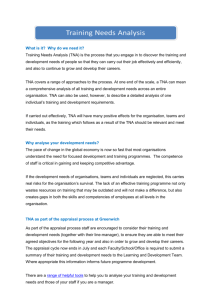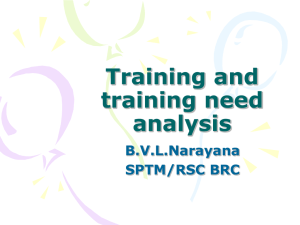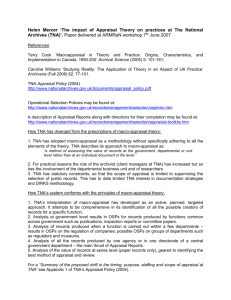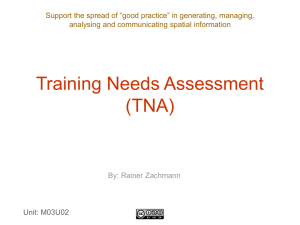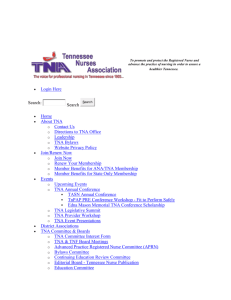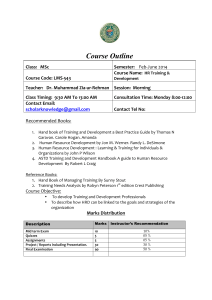Training Needs Analysis Guide - Local Government Association of
advertisement
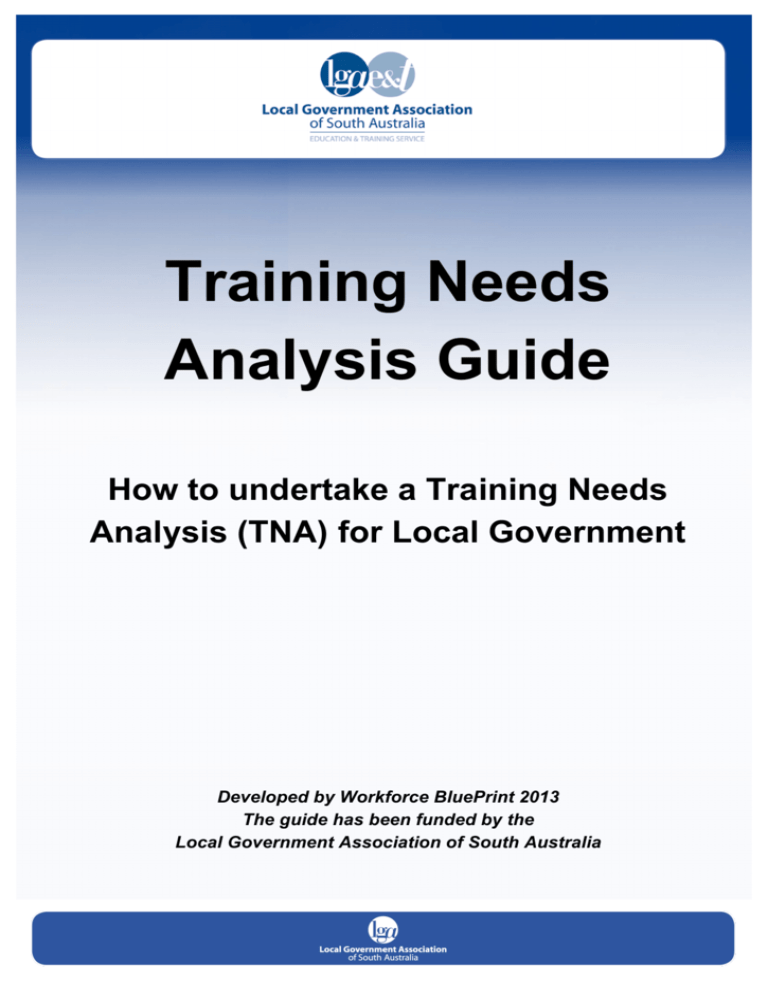
Training Needs Analysis Guide How to undertake a Training Needs Analysis (TNA) for Local Government Developed by Workforce BluePrint 2013 The guide has been funded by the Local Government Association of South Australia Contents Introduction ................................................................................................................................................ 3 Starting point for a TNA ............................................................................................................................ 3 What are you measuring and how?...................................................................................................... 6 Definitions .................................................................................................................................................... 9 TNA Methodologies .................................................................................................................................. 9 Addressing TNA gaps .............................................................................................................................. 10 Using the Job Skills Profiles in Skillsbook™ ............................................................................................ 10 Appendices .............................................................................................................................................. 16 Training Need Analysis Report Template ..................................................................................................... 17 Local Government Association of South Australia – Training Needs Analysis Guide Page 2 Introduction This guide has been development to assist Councils in South Australia to undertake a training needs analysis (TNA). The guide provides a step by step approach to undertaking a TNA using the library of common Local Government job skills profiles. Beginning with the starting point for a TNA, the reasons for a TNA, building a business case, measuring skills and training needs or competencies the process follows the TNA model and outlines key definitions. A fundamental benefit of a TNA is that the training programs delivered stem from the identification of actual skills/competency needs. Whilst this may seem perfectly logical, in many instances, particularly the government sector, training programs are offered to participants simply based on a training schedule that operates from one year to the next. Any program delivered based on performance needs is well-positioned to achieve outstanding results, again a strong case to conduct a TNA. Ideally the TNA could be part of the performance review process, undertaken on an annual basis. Training Needs Analysis Report Template A training needs analysis template has been developed for Councils to customise and is included as Appendix 1. The TNA steps in this manual are aligned to the TNA template and together with the analysis of the results from using the library of job skills profiles, will provide an organisational TNA report. The report template also follows the TNA Model at Figure 3. Starting point for a TNA Populate the TNA template as you work through this guide and firstly answer the question, why might we need to undertake a TNA? For example, is it to? Utilise the existing workforce resources Meet compliance, self-insured requirements and the Workplace Health and Safety one system Manage the numerous requests for training and prioritise development needs Provide evidence of capability for tenders, proposals, new products and services Meet audit requirements Support the implementation of the strategic and community plan Identify mandatory, common and priority development needs Manage significant change It is important to have the answer to this question consistent and agreed to by your executive team and stakeholders involved in the process. Other questions to answer at this stage include: Is there a sense of urgency and/or a deadline? Local Government Association of South Australia – Training Needs Analysis Guide Page 3 What is the scope and who do you need to consult and communicate with? How does the TNA fit within your performance management development process? Is it going to be annual? How is it going to be managed? What is the financial operational benefit associated with the project? What risks will the TNA address? How long it's going to take? Where will the evidence and information come from? Is the timing right? What resources do you need to undertake the training need analysis process? What are the objectives and targets for the TNA? Work Health and Safety requirements In the past, training systems have been identified as a key non-conformance issue within recent Workcover Evaluations. The Work Health and Safety Act 2012, identifies a number of requirements related to training including: Division 2—Primary duty of care, (3) (f) the provision of any information, training, instruction or supervision that is necessary to protect all persons from risks to their health and safety arising from work carried out as part of the conduct of the business or undertaking; and Division 4—Duty of officers, workers and other persons, 27 —Duty of officers (e) to ensure that the person conducting the business or undertaking has, and implements, processes for complying with any duty or obligation of the person conducting the business or undertaking under this Act; and Examples— For the purposes of paragraph (e), the duties or obligations under this Act of a person conducting a business or undertaking may include: • reporting notifiable incidents; • consulting with workers; • ensuring compliance with notices issued under this Act; • ensuring the provision of training and instruction to workers about work health and safety; Local Government Association of South Australia – Training Needs Analysis Guide Page 4 • (f) ensuring that health and safety representatives receive their entitlements to training. to verify the provision and use of the resources and processes referred to in paragraphs (c) to (e). Division 2—Consultation with workers, 49—When consultation is required (e) (f) when making decisions about the procedures for— (i) consulting with workers; or (ii) resolving work health or safety issues at the workplace; or (iii) monitoring the health of workers; or (iv) monitoring the conditions at any workplace under the management or control of the person conducting the business or undertaking; or (v) providing information and training for workers; or when carrying out any other activity prescribed by the regulations for the purposes of this section. The Work Health and Safety Regulations 2012 states in Part 2 – General workplace management, Division 1 – Information, training and instruction, 39-Provision of information, training and instruction (1)This regulation applies for the purposes of section 19 of the Act to a person conducting a business or undertaking. (2) The person must ensure that information, training and instruction provided to a worker is suitable and adequate having regard to— (a) the nature of the work carried out by the worker; and (b) the nature of the risks associated with the work at the time the information, training or instruction is provided; and (c) the control measures implemented. Maximum penalty: (3) (a) In the case of an individual—$6 000. (b) In the case of a body corporate—$30 000. The person must ensure, so far as is reasonably practicable, that the information, training and instruction provided to a worker is provided in a way that is readily understandable by any person to whom it is provided. Maximum penalty: (a) In the case of an individual—$6 000. (b) In the case of a body corporate—$30 000. Specific training requirements include but are not limited to: information, training and instruction to relevant workers in relation to implementing the emergency procedures. Local Government Association of South Australia – Training Needs Analysis Guide Page 5 proper use and wearing of personal protective equipment; and storage and maintenance of personal protective equipment. the nature of all hazards relating to a confined space; the need for, and the appropriate use of, control measures to control risks to health and safety associated with those hazards; the selection, fit, use, wearing, testing, storage and maintenance of any personal protective equipment; the contents of any confined space entry permit that may be issued in relation to work carried out by the worker in a confined space; emergency procedures. The person must ensure that a record of all training provided to a worker under this regulation is kept for 2 years. Refer to the The Work Health and Safety Regulations 2012 for the details of training requirements for specific activities. Business case Three main reasons for creating a business case: • To demonstrate the strategic alignment and sense of urgency of the project in question. (Does this project make sense?) • To define the scope of the proposed project. • To show the financial and operational benefits associated with the proposed project. There are also some secondary reasons. A good business case should help: • Identify risks inherent to the project and strategies for managing them. • Identify and understand rejected alternative solutions. • Target resource requirements (other than cash outlay) needed to accomplish the project. A good business case or proposal should serve as the foundation for an implementation plan or roadmap. What are you measuring and how? Understand what it is that you are measuring in the TNA process – is it skills and competency or capability? Capability includes skills and competences, values and behaviours, key performance indicators and targets or on the job performance as outlined in the model below: Local Government Association of South Australia – Training Needs Analysis Guide Page 6 Figure 1 This guide and the job skills profiles focus on skills and competencies. In terms of a good practice process, this guide follows the model below: Figure 2 Using the job skills profiles, employees self-assess against each skill or competency identifying where they: Local Government Association of South Australia – Training Needs Analysis Guide Page 7 Need development Are competent Can develop others This three point rating scale identifies both strengths and development needs. NB. Often people underrate themselves and may need support and/or validation of their selfassessment. To validate the facilitated self-assessment of skills and competencies, consider a mix of evidence, third party or supervisor verification, and the principles of assessment including validity, reliability, flexibility and fairness. The following model outlines steps in the TNA process: Figure 3 Step 1 covers the reasons why a TNA is needed, link with the Council’s strategic objectives and the impact of the internal and external environment on skills and training requirements. Step 2 outlines the current workforce profiles - the skills needs for the here and now workforce. This is where we look at the core competencies, any compliance or mandatory requirements; functional skill areas like management that are needed across multiple job roles, admin & IT, customer service or workforce health and safety; and then job specific skills that makes one job role different from another. Step 3 describes the future workforce skills profile and generally this is 1-3 years into the future with the structure of core/common, functional and job specific skills as a skills profile. Local Government Association of South Australia – Training Needs Analysis Guide Page 8 Step 4 is the gap analysis, comparing the current and future workforce skills profile, identifying areas of action and priorities in an action plan format. Common development needs across the organisation can be aggregated up from the self-assessments against skills profiles. Step 5 is where you implement the action plan; agree review timeframes and governance, monitor the outcomes. Definitions The TNA typically identifies skills/competency gaps impacting on organisational performance at three different levels e.g. industry needs - to be industry leaders; company needs - to achieve market share; department needs - to achieve sales targets; team needs - to improve teamwork, or individual needs - to increase productivity. All well-designed, results-based, comprehensive training programs consider the outcomes of a TNA by including the identified skills/competency needs in the program objectives. Here are some common definitions: Professional Development - skills and knowledge attained for both personal development and career advancement Training Needs Analysis (TNA) - also known as a gap needs analysis – identifies skills/competency gaps by isolating the difference in and between current and future skills/competency. This is achieved by collecting both qualitative and quantitative data for analysis. Vocational Education Training (VET) and Assessment – formal learning and assessment against units of competency and qualifications from National Training Packages or accredited courses through a Registered Training Organisation Workforce skills development – all forms of learning and skills acquisition Workforce development - bridges the gap between the current workforce and the desired workforce forecast Workforce planning - analysing workforce profile data and trends; forecasting demand; analysing supply; and undertaking a gap analysis A TNA can be described as a workforce development strategy and fits into the workforce planning process. TNA Methodologies There are different methodologies that can be used for a TNA. This guide focusses on building a job skills profile and assessing strengths and development needs against the profile. Alternative methodologies include: • Person analysis - profiling individuals, with a rating system: yes/no • Job analysis – triangulation by profiling 3 people’ skills in the same job role Local Government Association of South Australia – Training Needs Analysis Guide Page 9 • Organisation analysis against a current framework, option: sample across the organisation – job role based or risk management approach • Bottom up, problem based or profiling against a [future] skills/competency framework • SWOT analysis, Balanced Scorecard, surveying Generally to build job skills profiles you’ll need access to the up to date position description and information on the job role. Where job skills profiles use units of competency from the National Training System, the step to accreditation (if required) is made far easier as a skills map already exists. Addressing TNA gaps There are a number of ways to address gaps in skills identified by the TNA process aside from ‘training’ including: Using the Job Skills Profiles in Skillsbook™ Over 150 job skills profiles have been developed by Councils across South Australia as a joint resource for the purposes of undertaking a TNA. Skillsbook™ is an online tool that holds the job skills profiles that all Councils can access to download the profiles via the Local Government Association of South Australia licence. Steps to use Skillsbook™ Go to www.skillsbook.com.au and log in with this email address: lgaprofile@skillsbook.com.au and enter password: Skillsbook Local Government Association of South Australia – Training Needs Analysis Guide Page 10 The first screen is Manage Skills Portfolios where there is a list of the job skills profiles that have been developed: If you would like a list of all of the job skill profiles you can click on the blue Download button. Local Government Association of South Australia – Training Needs Analysis Guide Page 11 The Advanced Search function enables you to search for specific job skills profiles – mostly via the Position Title box. Choose a job skills profile to download, such as Volunteer Coordinator, and click on the View symbol: Local Government Association of South Australia – Training Needs Analysis Guide Page 12 The skills profile or portfolio has the structure of Core Capability, Functional Capability, and Job Specific Capability. NB. Please do not delete any skills or capabilities as this will impact on others using the library of job skill profiles. Download the skills profile as a pdf or excel file (option to include unit of competency code) and save onto your system: Local Government Association of South Australia – Training Needs Analysis Guide Page 13 Refer to the Volunteer Coordinator profile (separate document) in both pdf and excel format. The profile starts with the following information: Position Title, Business Unit and Business Team, Classification and VET Level relates to the level at which the profiler built the profile so you can adjust accordingly. There is the option of 2 types of rating: 1. Importance of the skill – high, medium and low 2. Rating for training needs – needs development, competent, can develop others Whilst you may not wish to use importance of the skill, rating for training needs is essential. Logout of the Skillsbook system via the Logout link in the top right hand corner of the screen. To use the job skill profiles with your employees to assess their training needs follow these steps: 1. Download the relevant job skills profiles 2. Modify, delete or add capabilities to the job skills profiles suit your Council 3. Provide a copy of the relevant job skills profile to each employee and explain the content and process 4. Employees then consider the skill and elements to determine a self-rating e.g. needs development, competent, can develop others 5. Self-rating can be validated by supervisor and/or peers ideally via a performance review/development process and recorded for the employee 6. Validated rated job skills profiles need to be collected and analysed centrally Local Government Association of South Australia – Training Needs Analysis Guide Page 14 7. Analysis of the results will identify priority and common development needs for core capabilities, functional capabilities and job specific capabilities 8. Reflect the analysis of the TNA job skill profile results in sections 2, 3 and 4 in the TNA template plus in section 6 the TNA template Remember to first implement your communication and consultation strategies with all stakeholders focussing on an outline of the TNA process, benefits and outcomes. Complete the TNA template from the beginning of the project and add content as you go. Local Government Association of South Australia – Training Needs Analysis Guide Page 15 Appendices Appendix 1 – TNA Report Template Appendix 2 – Volunteer Coordinator skills profile pdf Appendix 3 - Volunteer Coordinator skills profile excel Local Government Association of South Australia – Training Needs Analysis Guide Page 16 Training Need Analysis Report Template Council Name Version Number and Date Published Table of contents 1. Introduction and overview; Why? Methodology; Strategic Objectives; Internal and External environment 2. Current workforce profile 3. Future workforce profile 4. Gap analysis and closing strategies 5. Conclusion, review, evaluation strategy and next steps 6. TNA Action Plan 7. Consultation and Communication Strategy Local Government Association of South Australia – Training Needs Analysis Guide Page 17 1. Introduction and overview Background on the Council including core business functions/products/services. Why do we need to undertake a Training Needs Analysis? Why is it important? How does a TNA benefit our organisation/project? Explain links to audit results, compliance and Workplace Health and Safety requirements. What is the scope of this TNA? Will it cover the entire workforce; specific occupations or skill sets; occupations that are difficult to recruit or retain; or those occupations for a particular strategy/project? TNA Methodology Are you measuring Competency or Capability? Collecting Qualitative and/or Quantitative evidence? How will you engage the workforce? For example via working group/champions; Focus groups/forums; Surveys and incorporation of existing information; HR/Training team as advocates and supporters? Which approach are you using? Person analysis, Job analysis, Job skills profiles and employee evaluation, Organisation analysis, or Risk management approach? What Consultation and Communication strategies will you use? (see section 7) Strategic Objectives What are our organisation’s strategic objectives (link to strategic plan)? How do the strategic objectives link to a TNA? Vision; Mission; Goals; Strategic Priorities; Brands; Skills and Competencies; Values and Behaviours; KPIs Internal Environment Local Government Association of South Australia – Training Needs Analysis Guide Page 18 What is your current business planning process? What are the links between business planning and the TNA (timing, budget, performance review cycle)? What is the organisational structure (insert organisational chart)? What reports related to training needs across the structure are you interested in? What internal factors or issues will affect the success of your TNA? External Environment What is happening in the external environment? What are the external drivers of change? What are the impacts on your TNA? NB. May include Global factors; National factors; Industry factors; State/Territory Government factors; Regional/Local factors. What policies and initiatives (national, state, local) are being implemented or changed that may affect your TNA and the skills required by your workforce? Local Government Association of South Australia – Training Needs Analysis Guide Page 19 2. Current Workforce Profile What are the current skills and competencies of your workforce? What are the strengths and development needs? How would you rate the common skills, functional e.g. compliance, leadership, management and job specific skills? What is the consultation with your current workforce [and customers] telling you regarding training needs, what is working well or what could be improved? What are the current training priorities, based on the analysis of the evidence you have collected? What issues or challenges are affecting your TNA? 3. Future Workforce Profile Where are we headed? What is likely to change? What are the likely scenarios? What future job roles will be undertaken? What future products and services will be provided by the organisation (link to strategic plan)? What will the future environment require from our workforce in terms of skills? What skills and competencies are required over the next x years? What skills are required by all employees (common), by the leaders, for compliance, for specific functions and job roles? What are the future workforce skills priorities, based on the analysis of the evidence you have? What issues or challenges will affect your TNA into the future? 4. Gap Analysis and Closing Strategies Compare the current workforce skills and competencies with what is required into the future – what’s different; what do we need more of, less of? What gap closing strategies are required to build the desired workforce competencies or capabilities? What are the areas for action and development [training]? What are the gaps in terms of common/core skills, functional skills and job specific skills? What priority would you give each gap? Local Government Association of South Australia – Training Needs Analysis Guide Page 20 How does addressing the gap link back to your strategy? What development strategies could address this gap? Who will be responsible? What resources will be required and what are the timelines we are working towards. NOW…Complete the TNA Action Plan in section 6. 5. Conclusion, review, evaluation strategy and next steps What are the key outcomes of your TNA? Who will review the TNA, how often? How will you evaluate the development strategies in your TNA action plan? What are the next steps for implementation of your TNA action plan? What may be the success factors and the barriers to implementing this TNA action plan? How will you measure and evaluate transfer of skills and learning to the job role? Local Government Association of South Australia – Training Needs Analysis Guide Page 21 6. TNA Action Plan Links to our strategy Training Need Priority Number Mandatory Development Requirement strategies to address Y/N issues/needs Responsibilities Common/core skills Functional skills Job specific skills Local Government of South Australia – Training Needs Analysis Guide Page 22 Resources Partners Timelines and Frequency 7. Consultation and Communication Strategy Audience Key Messages Communication Strategies Consultation Strategies Local Government of South Australia – Training Needs Analysis Guide Resources & Responsibilities Page 23 Timelines

